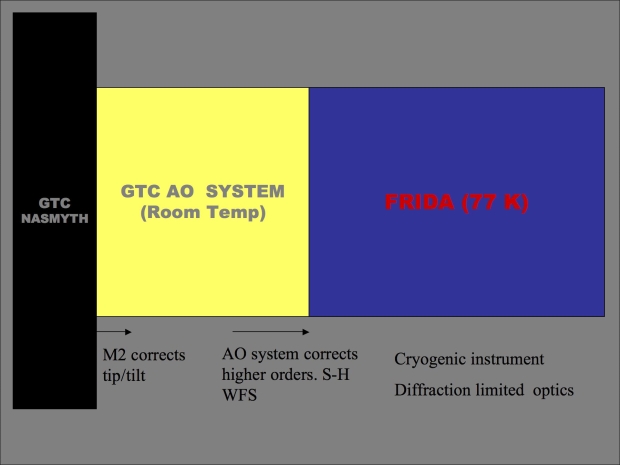
Instrument Overview

Instrument Overview |
The FRIDA Project Instrument Overview IAC Contribution IAC Project Team Science Drivers Sky coverage with AO with natural or laser guide star Other NIR instruments IAC programs on high spatial resolution techniques and atmospheric optics Contact Database (internal) |
FRIDA Concept:
FRIDA (inFRared
Imager and Dissector for Adaptive optics) is
the first instrument for the Adaptive
Optics system of the 10.4 m Gran Telescopio de
Canarias GTC × Near-IR imaging
× Near-IR integral
field spectroscopy
with three different
plate scales: × Coarse (0.040
arcsec/pixel)
× Mediun (0.020 arcsec/pixel)
× Fine (0.010 arcsec/pixel) FRIDA is optimized in the 1.1 -
2.4 µm range, in both imaging and
integral field mode. FRIDA Summary:
FRIDA Observation Modes:
(Image from Marin-Franch, Lenorzer, Herrero & Najarro, 2007)
(Image from Marin-Franch, Lenorzer, Herrero & Najarro, 2007)
FRIDA will be installed at the Nasmyth A platform behind the output focus of the GTC adaptive optic system (GTCAO.

Two unique capabilities of FRIDA with respect to current or planned 2D spectrographs are: 1) its high spectral resolution mode, 20,000; 2) its
separate imaging mode which will allow the observer very fast switch to the integral-field-spectroscopy - mode. The
combination will allow the user a fast selection of the field of
interest for follow up spectroscopy, and facilitate a fast acquisition
in the small FoV of the integral field unit. |
©Page maintained by the FRIDA group at the IAC